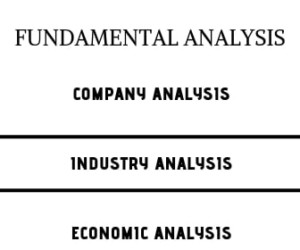When was the last time you used fundamental analysis? Learn secrets to grow your trading skills using fundamental analysis of stocks.
So, you want to become a stock market analyst? But do you know – investing in stocks requires a breakdown of risk. Stock market risk (or systematic risk) is the possibility of an investor or a trader experiencing losses. While stock market losses entitled several factors that affect the overall performance of the market. For instance, recession, economic factor, change in interest rate, natural disaster, political issues, etc. However, risk cannot be eliminated through diversification, though it can be a hedge against. Therefore, before buying any company’s shares it is important to analyse its fundamental strength.
Table of Contents
ToggleEmbarking Fundamental Analysis: Reconnect Bond With Stock Trading
There are several types of stock market analysis. The two basic methodology investors rely upon is technical analysis and fundamental analysis. Fundamental analysis is an operative parameter that you need to look at. Read further to know what is fundamental analysis.

Fundamental analysis aims to measure the value of an underlying company. It considers the company’s intrinsic value keeping in economic conditions. In addition, company financial condition of the industry to company performance. Incorporating fundamental strategies to our trader will help you reconnect bond.
A fundamental analyst would investigate balance sheet, profit and loss statement, and other data to predict the company’s future. Furthermore, the company’s financial value is determined to analyse its potential for future growth.
Fundamental Analysis Meaning
According to Wikipedia, “Fundamental analysis, in accounting and finance, is the analysis of a business’s financial statements (usually to analyze the business’s assets, liabilities, and earnings); health; and competitors and markets”. “It also considers the overall state of the economy and factors including interest rates, production, earnings, employment, GDP, housing, manufacturing and management. ”
So what is fundamental analysis? Fundamental analysis is an approach to measure economic health and financial performance of an underlying company. Each quarter publicly traded companies publish accounting reports using various metrics. Financial metrics, for instance, sales & debt data. This data helps shareholders to understand the company performance.
- In simple terms, it answers your following questions:
- Is it worth investing in a particular company?
- Will this company will return a profit?
- How much profit can be drawn?
- It is able to repay the debt?
- Is it strong enough to hold against competitors?
- Is management will be able to keep up with recession?
There are thousands of the company in the market from which to select. Often, investors use fundamental analysis as a way to filter through these company to narrow down the list. The fundamental analysis serves as an authoritative decision to analyse what to buy and sell unlike technical analysis, which helps to decide when to buy and sell stocks.
Distinguishing Two Analytics Model: Fundamental Analysis vs. Technical Analysis

Fundamental analysis and technical analysis are two common methodologies used to stock market analysis. Technical analysis is a trading discipline employed by short term traders. While fundamental analysis is an investing discipline employed by long term investors.
The important point for using fundamental analysis is the delay associated with the metrics provided to the public. The financial reports can release weekly, monthly, quarterly, or annually. Nonetheless, from the time of the performance reported to the time of analysis, there will be a delay.
Not according to technical analysis course, where charts are updated in real time. Each time there is a trade, you will get information. An investor using there reports distinguishing trades from other company.
Technical analyst forecast stock market prices based on mathematical studies of price movements. Whereas a fundamental analyst predicts stock market future value based on instinct value. That means, they determine the more future value by investing companies financial statements, history, cash flow, and other company reports.
In other words, fundamental metrics can help investors to identify companies which are leaders vs. lenders in their sector. Moreover, you do not have to use fundamental analysis to measure a company. You can also use to analyse a broader market including:
- Sectors in the economy
- Industries in Sectors
The difference between fundamental analysis and technical analysis is an undoubted topic. Learn more: technical analysis vs. fundamental analysis
Who Can Learn Fundamental Analysis to Survive in a Recession?

You do not require to be a professional share market expert to use fundamental analysis. If you are someone who loves to investigate how companies work, you are the right candidate to learn fundamental analysis course. In fact, learning how to read, analyse, and predict company future value can be useful for many individuals including
Money Lender
A moneylender gives off the loan for against a high return investment strategy. Beforehand, a lender investigates a company before giving a loan, besides buying bonds in a company they issue. Nevertheless, if you are concerned about getting your money back from the market, then you need to think before making a loan. Hence, the study of fundamental analysis will help you improve your ability to determine companies instrinsic value.
Stock Investors
Stock market investors those looking for buy company’s ownership stake can benefit from learning fundamental analysis. Because what they find about company information will help them to build a stock market investing strategy. Thus, empower investors to make an informed decision on buying and selling of securities.
Long Term Investors: Stock market is a riddle with uncertainties. However, certain principle those tried-and-tested can help investors boost chances for long-term success. Therefore, fundamental analysis can benefit long-term investors since stock prices and valuations ultimately reach parity during long-run.
Swing Traders
Swing traders hold their positions for a longer than a single day. Like every trader, swing trading isn’t for everyone. Eventually, it is an effective way to invest in the share market. A swing trader can utilize various fundamental tactics depending on their holding period.
Intraday Traders
Intraday traders are the one who is mostly affected by rumours, events and triggers price volatility. This often results as price gaps up or down in the market. Thus, day traders look forward to price action generated in the earnings report.
Certainly, background in financial analysis can help you dig even deeper into company statements. In this article, we’ll learn the basics of fundamental analysis with live examples. Even beginners in stock market analysis can use this guide to learn fundamental analysis.
Find Out Where Can You Learn Fundamental Analysis
IFMC Institute offers a comprehensive course for fundamental analysis. The course focus on the study of divide focus and charts to help measure the growth and sustainability of potential income stream. The fundamental analysis course is designed for working professional who can take the program anywhere and anytime.
Whereas classroom fundamental analysis course is available in Delhi, Noida, Ghaziabad. The program will develop advanced knowledge of how to use company data to support investing decision.
Fundamental Analysis Widget Components You Need To Know
Components of fundamental analysis of stocks can be broadly classified as Qualitative Analysis and Quantitative Analysis. Let’s understand both types of fundamental analysis.
Quantitative Analysis Model For Mathematical Valuation
Quantitative analysis (QA) is a mathematical financial analysis technique. The process collects and evaluated measurable data. In fact, expressed in numerical terms form. Subsequently, fundamental analysts focus on companies on the basis of its:
- Revenues
- Earnings
- Assets
- Debts
Qualitative Analysis Model – The Behaviour Instrument
Qualitative Analysis is a judgmental niche. It pretty much uses non-quantifiable information. Such as management expertise, industry information, and labour behaviour. The information collected cannot be expressed in numbers. But it relates to the nature of the company. Thus, it plays an important role to assess the company’s performance. Here are types of qualitative information you may need to consider:
- Competitive advantage
- Management performance
- Management experience
- Business Model
- Branding
Don’t Miss Out On Fundamental Analysis Tools
Fundamental analysis tools are the first love of investors. These tools will help you to analyze company financial position. So that you can derive considerable profits from investments. Thus, this serves the purpose of investing your hard earned money. Here is a Warren Buffet stock investing inspired fundamental analysis tools:
Earning Per Share (EPS)
Earning is the portion of the company profits allocated to every common stock. When analysing company’s financial position, we automatically love to perform the company. This performance is understood by measuring company earnings or its profitability. Thus, this profitability is calculated with the help of EPS.
EPS = Profits of the Period / No. of Standing Shares
Price to Earnings Ratio
Price to earnings ratio is the most common type of fundamental analysis. It is popularly known as P/E ratio. P/E ratio is defined as a ratio of company valuation that measures its current share price in relation to its per-share earnings. To calculate P/E ratio the
P/E Ratio = Price Per Share / Earnings Per Share
Let’s consider an example. Here is stock at $20 price per share. We take an estimate that its estimated earnings are $1. Then its P/E Ratio is 20.
If the earning per ratio increases to $2 then our P/E ratio will decrease to 10. P/E ratio is a good alternative approach to evaluation with regards to earnings.
Dividend Yield
This is another fundamental metric. Dividend Yield helps to evaluate both the price of the stocks and the performance of the company. In the measure, the ratio of annual dividend is calculated to subject to the price of a stock.
Dividend Yield = Annual Dividend / Price of Stock
Generally, stocks fall into three major three market capitalization category – large-cap stocks, Mid-caps stocks, and small caps stocks. To calculate the market capitalization of securities is take total shares outstanding and multiple with price per share.
How To Make Decision Using Fundamental Analysis
Fundamental analysis of stocks adds advantages to long-term investors. It helps to determine the intrinsic value of stocks. Thus, facilitate informed decisions whether this is the right tie to buy or sell a position trade ob basis of both current and past trends. Although, a smart investor must apply following different portfolio management styles:
Buy and hold
Buy and hold, also known as position trading is a passive investment strategy. A positional trade, a smart investor buys and hold stocks for the long term. Many fundamental analysts believe that latching on to good business enables investors assets to grow with the business. Fundamental analysis helps the investor to identify valuable companies with low risk and high earning probability.
Value investors
Unlike other investing strategies, value investing is simple. It does not require extensive knowledge of financial instruments. A value investor restricts focus on undervalued shares. They believe that it is a risk to invest in low return companies. Thus, the value they follow come from fundamental analysis. While money managers facilitate fundamental analysis to operating companies. Poor companies stock prices will eventually fluctuate, thereby, creating an opportunity for profits.
Contrarian investors
A contrarian investor believes in profits referrals. Their investment strategy is characterized by buying and selling in contrast to the prevailing sentiment of the time. Fundamental analysis allows contrarian investor to make independent value decisions while ignoring another investor opinion.
Example of Fundamental Analysis For Dummies

Let’s understand using an example:
Company Overview
Info Edge is a versatile Indian consumer internet domain. Founded in 1995, the company have more than 21+ years of experience in strong cash flow generation and diversified business portfolio. Thus, one of the few profitable internet plays in the world.
Business Portfolio
Info Edge is a versatile company. Operating in the diverse domain of recruitment, matrimony, real estate, education, financial advisor. With a network of 62 offices located in 43 cities throughout India, Info Edge has 4,049 employees engaged in innovation, product development, integration with mobile and social media, technology and technology updation, research and development, quality assurance, sales, marketing and payment collection.
Industry Analysis
The major business in info edge comes from Naukri.com. Moreover, with an increase in demand for skilled workers, more and more recruiters and employers are joining Naukri.com. Similarly, other segments of info edge are showing positive growth.

MOAT
Info Edge enjoys the leverage of being an autonomous online digital company. The company enjoys the two benefit of having 57 million employment database with 17000 being added daily and network source. However, measuring the company only of the basis of PE value is not enough.
Risk of Fundamental Analysis
Fundamental analysis is an attempt to measure a securities intrinsic value. With it’s rooted in qualitative and quantitative information, isn’t without any flaws. If the fundamental analysis of stocks was accurate, then everyone would use the approach to invest in the market, thereby to make profits. Then no one will ever lose money. Indeed, in reality, this is not true.
That’s why it’s important to understand the risk of fundamental analysis. This include:
- Vulnerability on wrong data: Fundamental analysis is strongly based on the company’s data. But if a company reports a wrong data or you misinterpret them, it increases chances of risk. Determining the wrong value of company likely result in making false assumptions. For instance, company growth, future, interest rates, profits etc.
- Dependence on past data: Biggest risk against fundamental analysis is that how many shares it comprehends in a company past performance. Over depending on the company past data can be risky. However, effective fundamental analysis of stocks considers using true historical data.
- Gambling against the market: If you think a stock is a showing investment potential just because you are affected like every one of the same data. If you see a stock is cheap which other investors are not able to see, then you are gambling.
Conclusion
Technical analysis is still an important part of stock analysis. It helps investors and professional traders to investment and trading. Above mentioned, fundamental metrics changes on a quarterly basis. They do not change from day to day, unlike technical analysis.
Fundamental analysis of stocks can be used as a way to narrow down universal stocks. Moreover, allow comparing countries economic value. For timing and risk management an investor may invest in technical analysis. This is an introductory guide. For more information visit IFMC Institute.





















